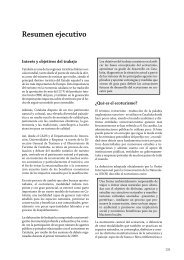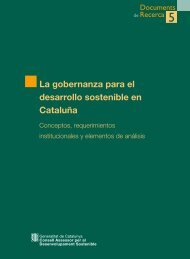Estratègies per al desenvolupament sostenible - Generalitat de ...
Estratègies per al desenvolupament sostenible - Generalitat de ...
Estratègies per al desenvolupament sostenible - Generalitat de ...
Create successful ePaper yourself
Turn your PDF publications into a flip-book with our unique Google optimized e-Paper software.
countries, as an<strong>al</strong>ysed and systemised by the OECD, the UNDP’s Capacity 21, theWorld Bank, the Internation<strong>al</strong> Institute for Environment and Development and theCADS itself with the programme <strong>de</strong>veloped with the IIG and very particularly on thework of the recent seminar on Strategies for Sustainable Development. Roles &Responsabilities <strong>al</strong>ong the Glob<strong>al</strong>-loc<strong>al</strong> Axis.This study provi<strong>de</strong>s no mo<strong>de</strong>l. What it does is take lessons from ex<strong>per</strong>ience an<strong>de</strong>xplain the reasons for the failure of some practices and the success of others. Thereis no point in seeking a unique mo<strong>de</strong>l, methodology or approach to sustainable<strong>de</strong>velopment. Strategies need to ex<strong>per</strong>iment with new ways of working; ex<strong>per</strong>ienceis constantly evolving and right now new methods are being <strong>de</strong>veloped and tested.What is now certain is that each country needs its own strategy. In some, coordinatingthe different processes un<strong>de</strong>rway and incorporating others will be enough.In others <strong>de</strong>veloping an integr<strong>al</strong> strategy might be more appropriate. Whatever formatis chosen the important factor is that the strategy fully befits each country’s institution<strong>al</strong>,economic, socio-cultur<strong>al</strong> and environment<strong>al</strong> circumstances. This, and working jointlywith the private sector and civil society organisations, is what counts.Nevertheless it is necessary to start by acknowledging that achieving a strategy thatensures sustainability is very difficult because it requires an ability to combine theshort and the long term, on the one hand, and to co-ordinate different government<strong>al</strong>and intergovernment<strong>al</strong> sectors, the private sector and civil society on the other. Infact, a good nation<strong>al</strong> strategy for sustainable <strong>de</strong>velopment should involve:Coherent association of a long-term outlook with the establishment of precisemedium-term go<strong>al</strong>s and actions to be un<strong>de</strong>rtaken in the short term.Efficient horizont<strong>al</strong> co-ordination of different sector<strong>al</strong> policies in or<strong>de</strong>r to ensurethat they <strong>al</strong>l share a basic commitment to sustainable <strong>de</strong>velopment.Vertic<strong>al</strong> or multi-level government ties to ensure that policies and governancethroughout the loc<strong>al</strong>/glob<strong>al</strong> axis enhance each other mutu<strong>al</strong>ly.Effective networks among governments, companies and voluntary and communityorganisations, on the basis of recognition that the complexity of the problems andthe fragmentation of capacities to <strong>de</strong><strong>al</strong> with them means that no group may besuccessful in acting <strong>al</strong>one 1 .1281 See OECD-UNDP. Sustainable Development Strategies. A Resource Book, compiled by Barry D<strong>al</strong><strong>al</strong>-Clayton and Stephen Bass. London, Sterling, VA: Earthscan Publications Ltd., p. 6. Our study isessenti<strong>al</strong>ly based on this text, which is available to anyone who wishes to have further information andknowledge.
















